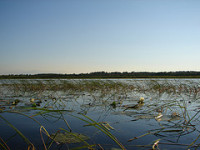Flood protectionWetlands function as natural sponges, that traps and slowly releases surface water, rain, snowmelt, groundwater and flood waters. Trees, root mats, and other wetland vegetation are also slowing the speed of flood waters and distribute them more slowly over the floodplains. This combined water storage and braking actions, lowers the flood heights and reduces erosion. |
More about:
More than one third of the US threatened species live in wetlands.
Wetlands are some of the most biologically productive natural ecosystems in the world.
Wetlands have important filtering capabilities.
Water storage is one of the important abilities of wetlands.
The ability of wetlands to control erosion is very valuable.
We use a wealth of natural products from wetlands and use them for recreation.
Global warming and lack of knowledge are reasons why wetlands are threatened ecosystems.
|

 Wetlands within, and downstream of urban areas are particularly valuable. They are counteracting the greatly increased rate and volume of surface and water runoff from pavement and buildings. The holding capacity of wetlands, helps control floods and prevents water logging of crops. Preserving and restoring wetlands, together with other
Wetlands within, and downstream of urban areas are particularly valuable. They are counteracting the greatly increased rate and volume of surface and water runoff from pavement and buildings. The holding capacity of wetlands, helps control floods and prevents water logging of crops. Preserving and restoring wetlands, together with other